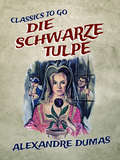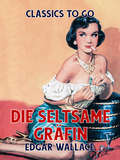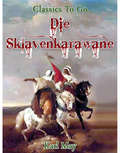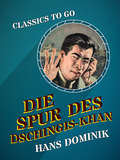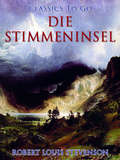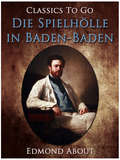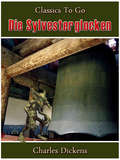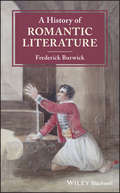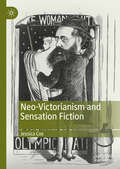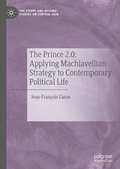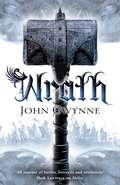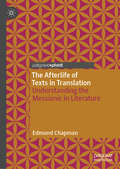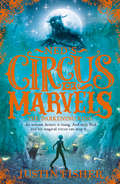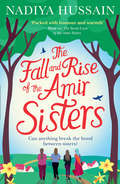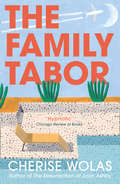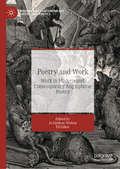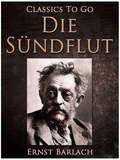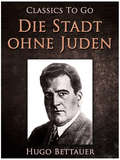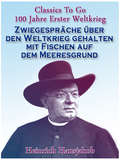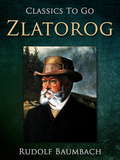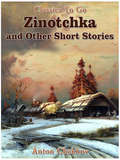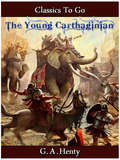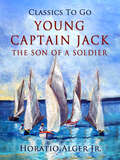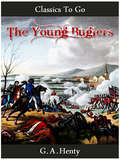- Table View
- List View
Die schwarze Tulpe (Classics To Go)
by Alexandre DumasDie schwarze Tulpe (französisch La Tulipe noire), eine Geschichte über den Tulpenzüchter Cornelius van Baerle und die schöne Rosa, ist einer der erfolgreichsten Romane von Alexandre Dumas. Niederlande, 1672: In einer Zeit politischer Wirren hat die Tulpengesellschaft von Haarlem einen Preis von 100.000 Gulden für denjenigen ausgesetzt, der eine schwarze Tulpe zu züchten vermag. Hierauf beginnt ein Wettstreit unter den besten Gärtnern des Landes um das Geld und den Ruhm. Der junge Cornelius van Baerle steht kurz vor dem Erfolg dieser als unlösbar erachteten Aufgabe, als er überraschend der politischen Aufrührerei bezichtigt und ins Gefängnis geworfen wird. Hier trifft er die schöne Tochter des Kerkermeisters, Rosa, in die er sich auf den ersten Blick verliebt. Sie hilft ihm, wo sie kann, und wird zum Schluss gar seine Retterin. Die schwarze Tulpe ist nicht nur ein aufregender Roman aus einer dramatischen Periode der niederländischen Geschichte, sondern auch eine Liebesgeschichte mit einem glücklichen Ende. (Wikipedia)
Die seltsame Gräfin (Classics To Go)
by Edgar WallaceDas Mädchen Lois wird Privatsekretärin der Gräfin von Moron. Merkwürdige Dinge geschehen in dem vornehmen Haus. Erst stürzt ein Balkon ein. Dann benimmt sich der Butler Braime verdächtig. Und schließlich entdeckt Lois ein rätselhaftes feines Drahtgeflecht an der Tür des Bücherschranks ... Kurze Zeit später wird die Bibliothek zum Schauplatz des Grauens.
Die Sklavenkarawane: Revised Edition Of Original Version (Classics To Go)
by Karl MayHauptfiguren sind zwei Forschungsreisende, die Brüder Emil Schwarz und Josef Schwarz, die getrennt im Sudan unterwegs sind. Mehrere Araber vom Stamme der Homr versuchen, Emil Schwarz auf seiner Reise nach Faschoda zu ermorden. Er überlebt den Anschlag unverletzt, nimmt die Araber seinerseits gefangen und übergibt sie dem Statthalter von Faschoda.
Die Spur des Dschingis-Khan (Classics To Go)
by Hans DominikIn seinem Roman Die Spur des Dschingis-Khan aus den Jahren 1922/23 plädiert die Hauptperson für eine „Rückführung“ schwarzer Bürger der USA auf den afrikanischen Kontinent. Figuren in Dominiks Romanen postulieren jedoch nicht die Unabänderlichkeit einer „Überlegenheit“ der „weißen Rasse“, sondern eine Art Verantwortung, „die Welt zu regieren, und dass in Zukunft eine andere Rasse (schwarz, gelb) käme, die die Bürde der Verantwortung von den Schultern nehmen werde“. (Wikipedia)
Die Stimmeninsel (Classics To Go)
by Robert StevensonRobert Louis Balfour Stevenson (* 13. November 1850 in Edinburgh; † 3. Dezember 1894 in Vailima, nahe Apia, Samoa) war ein schottischer Schriftsteller des viktorianischen Zeitalters. Stevenson litt an Tuberkulose und wurde nur 44 Jahre alt; jedoch hinterließ er ein umfangreiches Werk von Reiseerzählungen, Abenteuerliteratur und historischen Romanen sowie Lyrik und Essays. Bekannt geworden sind vor allem der Jugendbuchklassiker Die Schatzinsel und die Schauernovelle Der seltsame Fall des Dr. Jekyll und Mr. Hyde, die sich dem Phänomen der Persönlichkeitsspaltung widmet und als psychologischer Horrorroman gelesen werden kann. Einige Romane sind heute noch populär und haben als Vorlagen für zahlreiche Verfilmungen gedient. (Auszug aus Wikipedia)
Die Spielhölle in Baden-Baden (Classics To Go)
by Edmond AboutEdmond François Valentin About (* 14. Februar 1828 in Dieuze; † 16. Januar 1885 in Paris) war ein französischer Schriftsteller. Sein bekanntester Roman ist “Die Spielhölle von Baden-Baden”, die Handlung spielt in dem deutschen Kurort Baden-Baden zur Kaiserzeit, wo auf Grund von liberalen Glücksspielgesetzen ein sehr risikoreiches Kartenspiel »Trente et Quarante« gespielt wird: eine große Anzahl reicher Gäste und Berufsspieler sind diesem Spiel verfallen…
Die Sylvesterglocken: Ein Märchen Von Glocken, Die Ein Altes Jahr Aus- Und Ein Neues Jahr Einläuten (Classics To Go)
by Charles Dickens"Die Sylvesterglocken" im Origial "The Chimes" ist eine der beliebtesten Weihnachtsgeschichten von Charles Dickens.
A History of Romantic Literature (Blackwell History of Literature)
by Frederick BurwickHistorical Narrative Offers Introduction to Romanticism by Placing Key Figures in Overall Social Context Going beyond the general literary survey, A History of Romantic Literature examines the literatures of sensibility and intensity as well as the aesthetic dimensions of horror and terror, sublimity and ecstasy, by providing a richly integrated account of shared themes, interests, innovations, rivalries and disputes among the writers of the late eighteenth and early nineteenth centuries. Drawing from the assemblage theory, Prof. Burwick maintains that the literature of the period is inseparable from prevailing economic conditions and ongoing political and religious turmoil, as well as developments in physics, astronomy, music and art. Thus, rather than deal with authors as if they worked in isolation from society, he identifies and describes their interactions with their communities and with one another, as well as their responses to current events. By connecting seemingly scattered and random events such as the bank crisis of 1825, he weaves the coincidental into a coherent narrative of the networking that informed the rise and progress of Romanticism. Notable features of the book include: A strong narrative structure divided into four major chronological periods: Revolution, 1789-1798; Napoleonic Wars, 1799-1815; Riots, 1815-1820; Reform, 1821-1832 Thorough coverage of major and minor figures and institutions of the Romantic movement (including Mary Wollstonecraft, Elizabeth Montague and the Bluestockings, Lord Byron, John Keats, Letitia Elizabeth Landon etc.) Emphasis on the influence of social networks among authors, such as informal dinners and teas, clubs, salons and more formal institutions With its extensive coverage and insightful analysis set within a lively historical narrative, History of Romantic Literature is highly recommended for courses on British Romanticism at both undergraduate and post-graduate levels. It will also prove a highly useful reference for advanced scholars pursuing their own research.
Neo-Victorianism and Sensation Fiction
by Jessica CoxThis book represents the first full-length study of the relationship between neo-Victorianism and nineteenth-century sensation fiction. It examines the diverse and multiple legacies of Victorian popular fiction by authors such as Wilkie Collins and Mary Elizabeth Braddon, tracing their influence on a range of genres and works, including detective fiction, YA writing, Gothic literature, and stage and screen adaptations. In doing so, it forces a reappraisal of critical understandings of neo-Victorianism in terms of its origins and meanings, as well as offering an important critical intervention in popular fiction studies. The work traces the afterlife of Victorian sensation fiction, taking in the neo-Gothic writing of Daphne du Maurier and Victoria Holt, contemporary popular historical detective and YA fiction by authors including Elizabeth Peters and Philip Pullman, and the literary fiction of writers such as Joanne Harris and Charles Palliser. The work will appeal to scholars and students of Victorian fiction, neo-Victorianism, and popular culture alike.
The Prince 2.0: Applying Machiavellian Strategy to Contemporary Political Life (The Steppe and Beyond: Studies on Central Asia)
by Jean-François CaronThis Pivot updates the ideas of the famous political philosopher from the Italian Renaissance, Machiavelli, for the 21st century, using case studies from the West and from Kazakhstan to demonstrate the utility of Machiavelli's ideas for contemporary political life. In truth, Machiavelli's ideas have never lost their value. Although "Machiavellian" as an adjective tends to describe amoral cynicism in contemporary usage, Machiavelli's ideas were deeply ethical and oriented towards achieving long-term goals. Contemporary readers may be put off by medieval language and examples, misled into believing Machiavelli speaks to a different age; and yet the author here explores how Machiavellian strategy can be of value— ethical as well as practical—in the 21st century.
Wrath (The Faithful and the Fallen #4)
by John GwynneThe fourth in The Faithful and the Fallen series, Wrath by John Gwynne is the breathtaking, pulse-pounding conclusion to an epic series.It’s time to brave the final battle . . .Events are coming to a climax in the Banished Lands, as the war reaches new heights. King Nathair has seized the fortress at Drassil, and now possesses three of the Seven Treasures. And with Calidus and Queen Rhin, Nathair will do anything to obtain the rest. They will allow him to open a portal to the Otherworld – so Asroth and his demon-horde can break into the Banished Lands and finally become flesh.Meanwhile Corban has been captured by the Jotun, warrior giants who ride enormous bears into battle. His warband scattered, Corban must make new allies to survive. But can he bond with competing factions of warlike giants? Somehow he must, to counter the threat Nathair represents. His life hangs in the balance – and with it, the fate of the Banished Lands. Truth, courage and loyalty will be tested as never before.
The Afterlife of Texts in Translation: Understanding the Messianic in Literature
by Edmund ChapmanThe Afterlife of Texts in Translation: Understanding the Messianic in Literature reads Walter Benjamin’s and Jacques Derrida’s writings on translation as suggesting that texts exist within a process of continual translation. Understanding Benjamin’s and Derrida’s concept of ‘afterlife’ as ‘overliving’, this book proposes that reading Benjamin’s and Derrida’s writings on translation in terms of their wider thought on language and history suggests that textuality itself possesses a ‘messianic’ quality. Developing this idea in relation to the many rewritings and translations of Don Quijote, particularly the multiple rewritings by Jorge Luis Borges, Edmund Chapman asserts that texts consist of a structure of potential for endless translation that continually promises the overcoming of language, history and textuality itself.
The Darkening King (Ned’s Circus of Marvels #3)
by Justin FisherNed and the magical Circus of Marvels are back in a third rip-roaring, page-turning adventure!
The Fall and Rise of the Amir Sisters (Amir Sisters Ser.)
by Nadiya Hussain’Funny, warm and uplifting, Nadiya has produced a fabulous follow-up about faith and family’ OK! magazine
The Family Tabor: A Novel
by Cherise Wolas‘Hypnotic’ Chicago Review of Books ‘Rich, complex … vivid’ New York Times Book Review ‘Compelling’ Jewish Week Everything is fine. Everyone is fine.
Poetry and Work: Work in Modern and Contemporary Anglophone Poetry (Modern and Contemporary Poetry and Poetics)
by Jo Lindsay Walton Ed LukerPoetry and Work offers a timely and much-needed re-examination of the relationship between work and poetry. The volume questions how lines are drawn between work and non-work, how social, political, and technological upheavals transform the nature of work, how work appears or hides within poetry, and asks if poetry is work, or play, or something else completely. The book interrogates whether poetry and avant-garde and experimental writing can provide models for work that is less alienated and more free. In this major new collection, sixteen scholars and poets draw on a lively array of theory and philosophy, archival research, fresh readings, and personal reflection in order to consider work and poetry: the work in poetry and the work of poetry. Individual chapters address issues such as the many professions, occupations, and tasks of poets beyond and around writing; poetry’s special relationship with ‘craft’; work's relationship with gender, class, race, disability, and sexuality; how work gets recognised or rendered invisible in aesthetic production and beyond; the work of poetry and the work of political activism and organising; and the notion of poetry itself as a space where work and play can blur, and where postwork imaginaries can be nurtured and explored.
Die Sündflut, Drama in 5 Teilen (Classics To Go)
by Ernst BarlachErnst Barlach (* 2. Januar 1870 in Wedel; † 24. Oktober 1938 in Rostock; vollständiger Name: Ernst Heinrich Barlach) war ein deutscher Bildhauer, Schriftsteller und Zeichner. Barlach ist besonders bekannt für seine Holzplastiken und Bronzen. Außerdem hinterließ er ein vielgestaltiges druckgraphisches, zeichnerisches und literarisches Werk. Seine künstlerische Handschrift, sowohl in der bildnerischen als auch in der literarischen Arbeit, ist zwischen Realismus und Expressionismus angesiedelt. (Auszug aus Wikipedia)
Die Stadt ohne Juden (Classics To Go)
by Hugo BettauerMaximilian Hugo Bettauer (* 18. August 1872 in Baden bei Wien, Österreich-Ungarn; † 26. März 1925 in Wien, Österreich), war ein österreichischer Schriftsteller und Drehbuchautor. Zum Inhalt: Wien, Anfang der 20er Jahre. Zum Schutz des eigenen Volkes erlässt das österreichische Parlament ein Gesetz zur Ausweisung aller Nichtarier. Während die Juden in Scharen das Land verlassen, verkommt das ehedem weltstädtische Wien zu einem finanzschwachen und kulturlosen Dorf. Die Rettung kommt schneller als erhofft – durch den ungeahnten Coup eines Juden. Bettauers satirische Phantasie sollte nur wenige Jahre später zur bitteren Wirklichkeit werden. (Beschreibung von Amazon)
Zwiegespräche über den Weltkrieg gehalten mit Fischen auf dem Meeresgrund: Revised Edition Of Original Version (Classics To Go)
by Heinrich HansjakobBeeindruckt von den traurigen Bildern verwundeter und verkrüppelter Soldaten nach dem Beginn des ersten Weltkriegs verarbeitet Heinrich Hansjakob diese in einer Unterhaltung mit den Fischen auf dem Meeresgrund, die ja auch Zeugen von dem kriegerischen Geschehen auf den Meeren sind.Es entstspinnt sich ein langes Gespräch zwischen Hansjakob und Tiefseefischen, einem Katzenhai und einem Seedrachen, denen Hansjakob die Leiden der Menschen schildert und die er auch von der gerechten Sache, die Deutschland in diesem Krieg verteidigt, zu überzeugen sucht. (Auszug aus Wikipedia)
Zlatorog: Eine Alpensage (classic Reprint) (Classics To Go)
by Rudolf BaumbachRudolf Baumbach (* 28. September 1840 in Kranichfeld; † 21. September 1905 in Meiningen; Pseudonym Paul Bach war ein deutscher Dichter. Das Zlatorog (deutsch: Goldhorn) ist eine Sagengestalt aus den slowenischen Alpen. Im Triglav-Gebiet hat die Sage vom wilden weißen Gamsbock Zlatorog ihren Ursprung. Er hatte goldene Hörner und hoch oben am Triglav einen Garten und war zugleich Hüter eines verborgenen Schatzes. Als sich ein habgieriger Jäger des Schatzes bemächtigen wollte, schlich er sich an Zlatorog an und erschoss ihn. Aus dem Blut des getöteten Gamsbocks wuchs auf der Stelle eine Wunderblume, die Zlatorog das Leben zurückgab. In rasender Wut tötete Zlatorog den Übeltäter. Hernach zerstörte er seinen Gebirgsgarten und ward nie mehr gesehen. (Auszug aus Wikipedia)
Zinotchka and Other Short Stories (Classics To Go)
by Anton ChekhovAnton Pavlovich Chekhov was a Russian physician and author who is considered to be among the greatest writers of short stories in history. His career as a dramatist produced four classics and his best short stories are held in high esteem by writers and critics. Chekhov practised as a medical doctor throughout most of his literary career: "Medicine is my lawful wife", he once said, "and literature is my mistress.” This collection of ten of his best short stories include: Too Early Typhus Uprooted Vanka Verotchka Volodya Ward No. 6 Whitebrow Who Was To Blame? Zinotchka
The Young Carthaginian - A Story of The Times of Hannibal: Neubearbeitung Der Ungekürzten Originalfassung (Classics To Go)
by G. A. Henty"The Young Carthaginian" is set in ancient times, and tells the story of young Malchus, an officer in Hannibal's army, on his journey with the army across southern Europe and the Alps.
Young Captain Jack / The Son of a Soldier: The Son Of A Soldier (The World At War)
by Edward StratemeyerHoratio Alger, Jr.; January 13, 1832 – July 18, 1899) was a prolific 19th-century American author, best known for his many juvenile novels about impoverished boys and their rise from humble backgrounds to lives of middle-class security and comfort through hard work, determination, courage, and honesty. His writings were characterised by the "rags-to-riches" narrative, which had a formative effect on America during the Gilded Age. His popularity—and income—dwindled in the 1890s. In 1896, he had (what he called) a "nervous breakdown"; he relocated permanently to his sister's home in South Natick, Massachusetts. Before his death, Alger asked Edward Stratemeyer to complete his unfinished works.[56] In 1901, “Young Captain Jack” was completed by Stratemeyer and promoted as Alger's last work. Alger once estimated that he earned only $100,000 between 1866 and 1896; at his death he had little money, leaving only small sums to family and friends. His literary work was bequeathed to his niece, to two boys he had casually adopted, and to his sister Olive Augusta, who destroyed his manuscripts and his letters at his wish. (Excerpt from Wikipedia)
Young Captain Jack: The Son of a Sailor (Classics To Go)
by Jr. AlgerA civil war navel story - young Jack becomes a Caption and must show leadership and other personal growth and success principles to help his ship - he ends up a hero.
The Young Buglers: Revised Edition Of Original Version (Classics To Go)
by G. A. HentyThe heroes of this historical fiction book are two orphaned brothers, Tom and Peter Scudamore. They tell the story of the Peninsular War how they see it through their eyes. This war was a military conflict between France and the allied powers of Spain, the United Kingdom, and Portugal for control of the Iberian Peninsula during the Napoleonic Wars. The war started when French and Spanish armies occupied Portugal in 1807 and escalated in 1808, when France turned on its ally, Spain.
